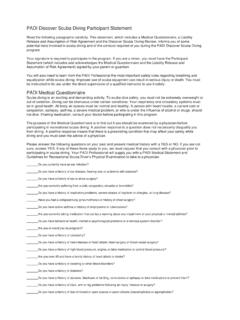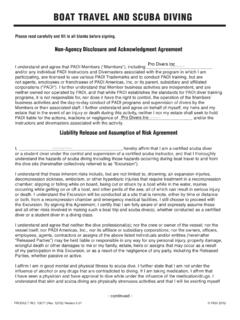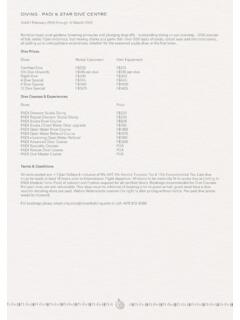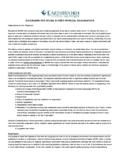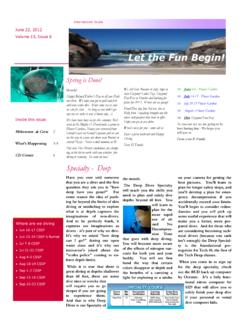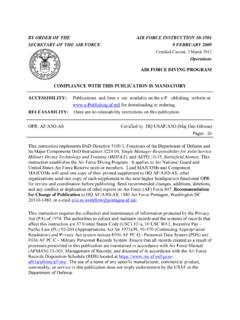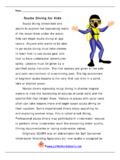Transcription of Scuba: Diving into Data at Facebook - Facebook Research
1 scuba : Diving into data at FacebookLior Abraham John AllenOleksandr BarykinVinayak BorkarBhuwan ChopraCiprian GereaDaniel MerlJosh MetzlerDavid ReissSubbu SubramanianJanet L. WienerOkay ZedFacebook, Inc. Menlo Park, CAABSTRACTF acebook takes performance monitoring seriously. Performanceissues can impact over one billion users so we track thousands ofservers, hundreds of PB of daily network traffic, hundreds of dailycode changes, and many other metrics. We require latencies ofunder a minute from events occuring (a client request on a phone, abug report filed, a code change checked in) to graphs showing thoseevents on developers is the data management system Facebook uses for mostreal-time analysis. scuba is a fast, scalable, distributed, in-memorydatabase built at Facebook .
2 It currently ingests millions of rows(events) per second and expires data at the same rate. scuba storesdata completely in memory on hundreds of servers each with 144GB RAM. To process each query, scuba aggregates data from allservers. scuba processes almost a million queries per day. scuba isused extensively for interactive, ad hoc, analysis queries that run inunder a second over live data . In addition, scuba is the workhorsebehind Facebook s code regression analysis, bug report monitoring,ads revenue monitoring, and performance INTRODUCTIONAt Facebook , whether we are diagnosing a performance regres-sion or measuring the impact of an infrastructure change, we wantdata and we want it fast. The Facebook infrastructure team relieson real-time instrumentation to ensure the site is always runningsmoothly.
3 Our needs include very short latencies (typically under aminute) between events occuring on the web servers running Face-book to those events appearing in the graphs produced by and speed in querying data is critical for diagnosingany issues quickly. Identifying the root cause for a issue is oftendifficult due to the complex dependencies between subsystems atFacebook. Yet if any issues are not fixed within minutes to a fewhours, Facebook s one billion users become unhappy and that isbad for Facebook . Lior Abraham, John Allen, and Okay Zed were key early con-tributors to scuba who have left Facebook . Vinayak Borkar is aFacebook graduate fellow from to make digital or hard copies of all or part of this work forpersonal or classroom use is granted without fee provided that copies arenot made or distributed for profit or commercial advantage and that copiesbear this notice and the full citation on the first page.
4 To copy otherwise, torepublish, to post on servers or to redistribute to lists, requires prior specificpermission and/or a fee. Articles from this volume were invited to presenttheir results at The 39th International Conference on Very Large data Bases,August 26th - 30th 2013, Riva del Garda, Trento, of the VLDB Endowment, Vol. 6, No. 11 Copyright 2013 VLDB Endowment 2150-8097/13 $ , we relied on pre-aggregated graphs and a carefullymanaged, hand-coded, set of scripts over a MySQL database of per-formance data . By 2011, that solution became too rigid and could not keep up with the growing data ingestion and queryrates. Other query systems within Facebook , such as Hive [20] andPeregrine [13], query data that is written to HDFS with a long (typ-ically one day) latency before data is made available to queries andqueries themselves take minutes to , we built scuba , a fast, scalable, in-memory is a significant evolution in the way we collect and analyzedata from the variety of systems that keep the site running everyday.
5 We now use scuba for most real-time, ad-hoc analysis of arbi-trary data . We compare scuba to other data management systemslater in the paper, but we know of no other system that both ingestsdata as fast and runs complex queries as fast as , scuba runs on hundreds of servers each with 144 GBRAM in a shared-nothing cluster. It stores around 70 TB of com-pressed data for over 1000 tables in memory, distributed by par-titioning each table randomly across all of the servers. scuba in-gests millions of rows per second. Since scuba is memory-bound,it expires data at the same rate. To constrain the amount of data , scuba allows rows to specify an optionalsamplerate, which in-dicates that scuba contains only a fraction (often 1 in 100 to 1 in1,000,000) of the original events.
6 This sampling is necessary forevents like Facebook client requests, which occur millions of timesper second. Sampling may be either uniform or based on somekey, such as user id. scuba compensates for the samplerate whencomputing addition to a SQL query interface (for a subset of SQL in-cluding grouping and aggregations but not joins), scuba providesa GUI that produces time series graphs, pie charts, distributions ofcolumn values, and a dozen other visualizations of data besides ta-bles with text. Figure 1 shows a time series graph with a week overweek comparison of page traffic in the scuba GUI. In the backend,an aggregation tree distributes each query to every server and thengathers the results to send back to the scuba was built to support performance analysis, itsoon became the system of choice to execute exploratory queriesover other time-sensitive data .
7 Many teams at Facebook use scuba : Mobile development teams use scuba to track which frac-tions of users are running different mobile devices, operatingsystems, and versions of the Facebook app. Ads uses scuba to monitor changes in ad impressions, clicks,and revenue. When a drop occurs, they can narrow it downquickly to a particular country, ad type, or server cluster anddetermine the root 1: scuba s web user interface. The query shown on the left side generates a time series graph with a week over weekcomparison of three columns related to Facebook page dispatches. The dotted lines represent the same days one week earlier. It isvery easy to see daily and weekly cyclical behavior with these graphs. Site reliability watches server errors by using scuba .
8 Whena spike occurs, they can pinpoint whether it is due to a bug ina particular endpoint, a service in a particular datacenter orserver cluster, or a physical issue with part of a datacenter. Bug report monitoring runs thousands of queries every hourto look for spikes in the number of bugs reported by Face-book users, grouped by dozens of demographic dimensions(location, age, friend count, etc).In general, users start by asking high-level aggregate queries toidentify interesting phenomena in their data and then dive deeper(hence the name scuba ) to find base data points of interest. In allof the above cases, being able to break down the data along multipledimensions in an ad hoc manner is is also the engine that underlies Facebook s code regres-sion analysis tool, bug report monitoring tool, real-time post con-tent monitoring tool ( , how many Facebook posts mention themovie Argo ?)
9 , and many other tools. The key feature of scuba isthat queries take less than a second to execute, even when scanninghundreds of GB of data , and results are usually live over events thatoccurred a minute Section 2, we describe some of the use cases supported byScuba at Facebook , including performance monitoring, trend spot-ting, and pattern mining. A detailed description of scuba s archi-tecture, storage, and query capabilities is in Section 3. We present asimple analytical model of scuba s query execution in Section 4. InSection 5, we evaluate scuba experimentally. We study its speedupand scaleup properties with real data and queries. In Section 6, wecompare scuba to related work. We conclude in Section 7 with alist of ways that scuba differs from most other database find that these differences make scuba suit our use cases scuba USE CASESS cuba currently stores over 1000 tables.
10 In this section, we de-scribe a few representative use cases of Performance MonitoringThe original and most common use of scuba is for real-timeperformance monitoring. Julie monitors the performance of She starts by looking at a scuba dashboard of tens ofgraphs showing CPU load on servers; numbers of cache requests,hits, and misses; network throughput; and many other graphs compare performance week over week, as in Fig-ure 1, or before and after a big code change. Whenever she findsa significant performance difference, she then drills down throughdifferent columns (often including stack traces), refining the queryuntil she can pin the difference to a particular block of code and fillout an urgent bug s dashboard runs canned queries over data that is no morethan seconds old.
